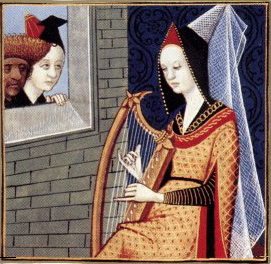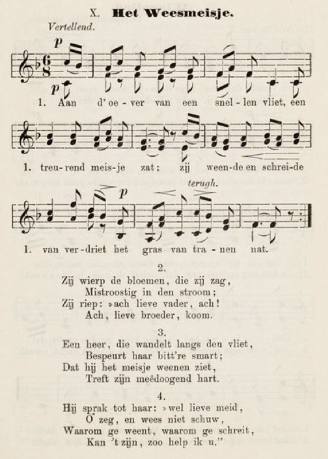|
Dutch folk songs with music and translation
Over 75 well-known folk songs translated in English
With music !

|
|
Did you hear about the treasure fleet
Heb je van de zilveren vloot wel gehoord
The horn sounds along the mountain and dale
Langs berg en dal klinkt hoorngeschal
In a blue chequered peasant smock
In een blauwgeruiten kiel
In name of the prince, open these city gates
In naam van Oranje, doet open de poort
In this green valley, peaceful, quiet
In 't groene dal, in 't stille dal
Jan Double Jan, is no longer found at the yearly fair
Dubbele Jan die zie je niet meer op de kermis staan
May has arrived in our land
De meimaand is in 't land
|
|
A small wooden cart, the moon was bright
Een karretje op een zandweg reed
Small tiny bird on your green branch
Klein vogelijn op groenen tak
Take any path you like, take any road you like
De paden op, de lanen in
Time flies like a passing shadow
Uren, dagen, maanden, jaren
Wake up, look the sun is high in the sky
Word wakker het zonnetje is al op
When Duke Jan arrived here on his horse
Toen den Hertog Jan kwam varen
Where the white and gleaming dune top
Waar de blanke top der duinen
|
All join here together
Komt allen tezamen
Angels floating in the heavens
Engelkens door het luchtruim zwevend
Cold is this little Child, cold is the air
Hoe leit dit Kindeke hier in de kou
The divine Child is born today
't Is geboren, het godd'lijk Kind
Honour to God, high in heaven
Ere zij God, in den hoge
Jesus, little, small
Klein, klein Jezuken
A little Child is born now into the world
Er is een Kindeke geboren op aard
Midnight in this winter night
Midden in de winternacht
|
|
Now be welcome with us, Jesus our dear Lord
Nu zijt wellekome, Jesu, lieve Heer
Oh, Christmas night, brighter than the day
O Kerstnacht, schoner dan de dagen
Oh litte Child small, oh little Child frail
O Kindeke klein, o Kindeke teer
Oh shepherds abandon sheep and goats promptly
O herders, verlaat uw bokjes en schapen
Shepherds, he has been born in
Herders, hij is geboren
The shepherds were lying round midnight
De herdertjes lagen bij nachte
Silent night, holy night
Stille nacht, heilige nacht
|
|

Medieval noble woman playing the harp
15th century
(BnF, MS Français 599, f.68).
About Dutch folk songs
A folk song ('volksliedje') means in Dutch a song that is sung by the common people (not performed by an artist). A folk song ('volksliedje') lives in the oral tradition and is verbally passed on from one generation to another. An author or composer is not known anymore by the singers.
Folk songs are especially meant for singing (not listening). For example: the songs have much repetition in word and tune; it's easy to learn and sing along; there are no musical bars with only instrumental music (because it would be a pause in the singing without instruments); and often melody is imitated by sound-imitations like "lalala" and "tiereliere".
Because it's passed down orally (by word of mouth), variants come into existance and develop, both in lyrics and music. A folk song consists of a range of variants, with no one true shape (in lyrics or music), because the original song, the original author and composer, are not known anymore. Scientists always study the complex of a song (on this website is chosen for one variant, explained in the Colophon, under 'Selection').
Folk songs cover many genres, for example: love songs, narrative songs, historical songs, Sea Beggar's songs, sailor songs, religious songs, mockery songs, murder songs, Saint Martin songs, Saint Nicholas songs, Christmas songs, children's songs, etcetera.
Folks songs can also be classified by their function, like: working songs, weaving songs, street songs, dansing songs, drinking songs, etcetera.
In the 17th and 18th century, song books were very popular in the Netherlands. Thousands were published. Many of these songs became well-known under the common people. Besides books, also many single (seperate, detached) song sheets (broadsides) with folk songs were published. They were sold by professional market singers, but also by poor or disabled people. Unfortunately most of them were lost, because they were considered as articles of everyday use (and made good toilet paper) - but still vast collections (of over 5000 sheets) were preserved (in the Royal Library and other research institutes).
In the 19th century, under influence of the Romanticism, many folk songs were for the first time written down and printed by researchers. The ideal was to look for the roots of the culture. Most important was the collection of F. van Duyse, The old Dutch song / Het oude Nederlandsche lied (1903-08, 4 volumes), with 714 folk songs, over 1500 versions and over 1000 musical notations. The folk songs in all these publications and collections can be older of course than the 19th century. Most of these folk songs, written down from the oral tradition, in fact cannot be dated.
In the 19th and 20th century some song writers began to write new songs in the style of folk songs (meant for the active singing tradition). Many of these songs became very popular. Most successful was Jan Pieter Heije, who was influenced by the Enlightenment. Many of his songs are still known today, like: "Did you hear about the treasure fleet"; "In this green valley, peaceful, quiet"; "A small wooden cart, the moon was bright"; and "Small tiny bird on your green branch".
Very influential in the 20th century was the song book Can you still sing, then sing along (collected by Jan Veldkamp and Klaas de Boer, 1906). It was in print the whole century (out of print in 2012) and a record of roughly a million (!) copies were sold. Together with songs of J.P. Heije, it contained well-known songs like "In name of the prince, open these city gates"; "The horn sounds along the mountain and dale"; "On the big, vast heathland, a shepherd lonely wanders"; "Time flies like a passing shadow"; and "Where the white and gleaming dune top".
Later in the 20th century the song book Dutch folk song was published (collected by Jop Pollmann and Piet Tiggers, 1941). It became very popular and sold almost 500.000 copies (last print in 1977). Their ideal was to sing again old, traditional folk songs, because the singing itself had to be most important in musical education. This ideal was spread in several youth organisations, and also carried out by Renske Nieweg, a music teacher on the School for Elementary Education. Under her motivational teaching, many young teachers started to use folk songs in their lessons and many historic songs became widely known again in the 1940's-1960's.
During the 1960's and 1970's, the popularity of singing folk songs decreased. The pop and rock songs from the radio, especially in the English language, became very popular in the decades after the Second World War. From the eighties singing in Dutch was slowly but surely revalued in the pop music. But the listening to pop songs, both in English as in Dutch, displaced the singing of folk songs.
The best, scientific source of folk songs (from medieval times till the 20th century) is the Dutch Song Database. It is an online database with over 170.000 folk songs (including versions). It is run by the Meertens Instituut (a research institute of Dutch language and culture), part of the Royal Dutch Acadamy of Science. You cannot only find a song on first line or refrain, but also all versions and all melody-lines are connected. It's also possible to search for contrafacta, by characteristics of the strophes.
The music group for historic folk music, Camerata Trajectina, released over 40 cd's (still available in the webshop on their site) with Dutch songs from the Middle Ages, the Eighty Year's War of Independence, songs by Hooft and Vondel, 19th century street songs, etc. etc. They were awarded with an Edison Music Award in 2006.
Most of the mentioned songs can be found on this website. Have fun with these old, traditional and well-known Dutch folk songs!
By Rozemarijn van Leeuwen
(I earlier wrote about this, in more detail, on the Dutch Wikipedia, 'Volkslied'/'Liedblad'/'Liederenbank', about all the mentioned songbooks, etc., with references and sources)
|


Two song sheets (broadsides) with Dutch folk songs.
∗ ∗ ∗
|
|
From The farmer had just one shoe
(De boer had maar enen schoen)
|
|
|
up to My Sarie Marais is so far from my heart
(My Sarie Marais is so ver van my hart)
|
|
|
From Once there where two young king's children
(Het waren twee conincskinderen)
|
|
|
up to Jan Double Jan, is no longer found at the yearly fair
(Dubbele Jan die zie je niet meer op de kermis staan)
|
|
|
From In this green valley, peaceful, quiet
(In 't groene dal, in 't stille dal)
|
|
|
up to Three drummers young, were marching from the east lands
(Drie schuintamboers die kwamen uit het oosten)
|
∗ ∗ ∗

Two market singers singing folk songs on a fair (1892).
Search all Dutch folk songs
alphabetically
∗ ∗ ∗
 Didn't you find the song you were looking for? Didn't you find the song you were looking for? 
Visit our Dutch websites with Dutch songtexts:
Over 3000 Dutch and English songtexts
of well-known songs in The Netherlands:
www.songteksten.overtuin.net
∗ ∗ ∗

Frans Hals,
Young man with a lute
(ca. 1625).
  
herzlich willkommen ~ bienvenue ~ bienvenido
niederländische Volkslieder aus den Niederlanden, die Niederlande, Holland, traditionelle historische Volkslieder mit Musik, mittelalterliche Lieder mit Übersetzung in Englisch ~ ~ chansons folkloriques de pays bas, chansons traditionnel historique néerlandais, Hollande, chansons médiévales avec de la musique, avec traduction en anglais ~ ~ canciones folk de Países Bajos, Holanda, canciones tradicional histórico holandès, canciones medievales con música, con la traducción en Inglés
  
|
In the Overtuin
Dutch songs with music and English translation
sitemap
© copyright
translations, sheet music and music
|







 Didn't you find the song you were looking for?
Didn't you find the song you were looking for? 
